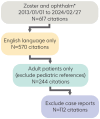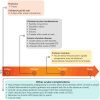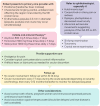Herpes Zoster Ophthalmicus: Presentation, Complications, Treatment, and Prevention
- PMID: 38834857
- PMCID: PMC11219696
- DOI: 10.1007/s40121-024-00990-7
Herpes Zoster Ophthalmicus: Presentation, Complications, Treatment, and Prevention
Abstract
Herpes zoster (HZ) is caused by reactivation of latent infection of varicella zoster virus (VZV) in sensory (cranial, dorsal root) ganglia. Major risk factors for HZ are increasing age and immunosuppression. HZ ophthalmicus (HZO) is a subset of HZ with involvement of the ophthalmic division of the fifth cranial trigeminal nerve. Approximately 4-20% of patients with HZ develop HZO. Approximately 50% of patients with HZO develop ocular disease, among whom up to 25% develop chronic or recurrent disease. Common manifestations of ocular disease include conjunctivitis, keratitis, and uveitis, whereas optic neuropathy and retinitis are uncommon. Due to the potential for vision impairment, ocular involvement requires urgent ophthalmic consultation. Early recognition and timely treatment with antivirals may prevent ocular complications. HZO is preventable by vaccination against HZ. Vaccine efficacy/effectiveness studies have been largely conducted for HZ with few studies assessing HZO. Both the recombinant adjuvanted vaccine (RZV) and live-attenuated vaccine (ZVL) significantly reduce the incidence of HZ and HZO in older adults. RZV is more effective than ZVL. Data on the effectiveness of vaccines for prevention of recurrent disease in patients with HZO are limited; however, vaccination is recommended. Despite recommendations to vaccinate individuals likely to benefit from an HZ vaccine, coverage for adults remains suboptimal. Barriers to vaccination include patient beliefs about HZ or HZ vaccines, and factors related to healthcare providers. In particular, the lack of a recommendation from their primary care physician is often cited by patients as a reason for remaining unvaccinated. By encouraging vaccination against HZ, physicians not only prevent HZ and HZO but also potential vision loss due to HZO.Graphical abstract available for this article.
Keywords: Herpes zoster; Herpes zoster ophthalmicus; Herpes zoster vaccination; Ocular complications; Prevention; Primary care; Treatment.
Plain language summary
Shingles, also known as herpes zoster, is a common and painful rash that develops when the virus that causes chickenpox in children reactivates, most often in adults. When shingles affects the eye or the area surrounding the eye, it is called herpes zoster ophthalmicus, or HZO for short. Up to one-fifth of people with shingles have HZO, and this risk increases with age and in people with other conditions that affect their immune system. Common signs and symptoms include a rash on the face, pain, fever, and headache, as well as symptoms in the eye, such as discomfort, redness, and discharge. HZO has the potential to cause permanent vision loss, and because of this, it is important that people with symptoms are referred to an eye doctor (“ophthalmologist”) as soon as possible. Early diagnosis of HZO is essential for effective treatment and prevention of the more serious complications it can cause. Treatment within 3 days of the symptoms occurring, with medications known as antivirals, can shorten the duration of a shingles episode and help relieve the pain. To help prevent the risk of shingles and its subtypes like HZO, vaccination is recommended. Two vaccines are currently approved for the prevention of shingles in adults. Although these vaccinations are recommended, some people do not have them for various reasons, which include their own personal beliefs about vaccinations or that their doctor has not recommended it to them. It is important that vaccinations against shingles are recommended to all patients eligible to receive one.
© 2024. GSK.
Conflict of interest statement
John Litt has received payment and/or honoraria from GSK, Merck, Pfizer, Sanofi, and Seqirus, and served as a member of the Immunisation Coalition Scientific Advisory Committee. Anthony L. Cunningham’s institution has received payment and/or honoraria from AbbVie, Curevo, GSK, HealthEd, Merck, Moderna, and Seqirus. Francisco Arnalich-Montiel has no conflicts of interest to disclose. Raunak Parikh is an employee of GSK and holds stock or stock options.
Figures




References
-
- Gross GE, Eisert L, Doerr HW, et al. S2k guidelines for the diagnosis and treatment of herpes zoster and postherpetic neuralgia. J Dtsch Dermatol Ges. 2020;18(1):55–78. - PubMed
Publication types
LinkOut - more resources
Full Text Sources

